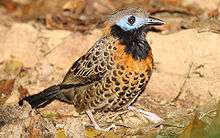Ocellated antbird
| Ocellated antbird | |
|---|---|
 | |
| Scientific classification | |
| Kingdom: | Animalia |
| Phylum: | Chordata |
| Class: | Aves |
| Order: | Passeriformes |
| Family: | Thamnophilidae |
| Genus: | Phaenostictus Ridgway, 1909 |
| Species: | P. mcleannani |
| Binomial name | |
| Phaenostictus mcleannani (Lawrence, 1861) | |
The ocellated antbird (Phaenostictus mcleannani) is a species of antbird in the Thamnophilidae family. It is monotypic within the genus Phaenostictus and found in Colombia, Costa Rica, Ecuador, Honduras, Nicaragua, and Panama. Its natural habitat is the understory of moist lowland forests, foothill forest, and tall secondary growth woodlands.
The species is 19 cm long and weighs around 50 g. The eye is surrounded by a large area of bare blue coloured skin. The plumage varies slightly amongst the three subspecies, but overall it has a grey crown, black throat with a buff breast changing into a spotted belly and back.
The bird feeds primarily on insects, arthropods, and sometimes on small lizards. Most of its prey is obtained from trails of army ants, which flush the prey from hiding places. One such army ant species is Eciton burchellii. The ocellated antbird is considered an obligate follower of army ants, seldom foraging away from swarms. Amongst the species of antbirds and other army ant followers (such as tanagers and woodcreepers) it is usually a dominant species.
The social biology of this species is unusual for the antbird family. The breeding pair form the nucleus of a group or clan that includes their male offspring and their mates. These clans work together to defend territories against rivals. The open nest cup was only recently described, with a clutch of two eggs.[2]
The ocellated antbird was described by the American amateur ornithologist George Newbold Lawrence in 1861 and given the binomial name Phlogopsis mcleannani (misspelled as Meleannani). The specific epithet honours James McLeannan who collected the specimen in Panama.[3] The genus Phaenostictus was erected in 1909 by the American ornithologist Robert Ridgway.[4]
References
- ↑ BirdLife International (2012). "Phaenostictus mcleannani". IUCN Red List of Threatened Species. Version 2013.2. International Union for Conservation of Nature. Retrieved 26 November 2013.
- ↑ Buehler, Deborah M.; Castillo, Alberto I.; Brawn, Jeffrey D. (2004). "First nest description for the Ocellated Antbird (Phaenostictus mcleannani)". Wilson Bulletin. 116 (3): 277–279. doi:10.1676/04-006.
- ↑ Lawrence, George Newbold (1862). "Descriptions of new species of birds of the genera Myiarcus and Phlogopsis". Annals of the Lyceum of Natural History of New York. 7: 284-286 [285-286]. The volume is dated 1862 but the article was published in 1861.
- ↑ Ridgway, Robert (1909). "New genera, species and subspecies of Formicariidae, Furnariidae, and Dendrocolaptidae". Proceedings of the Biological Society of Washington. 22: 69–74 [70].
- del Hoyo, J.; Elliot, A. & Christie D. (editors). (2003). Handbook of the Birds of the World. Volume 8: Broadbills to Tapaculos. Lynx Edicions. ISBN 84-87334-50-4
Further reading
- Willis, Edwin O. (1973). The Behavior of Ocellated Antbirds. Smithsonian Contributions to Zoology, Number 144. Washington: Smithsonian Institution Press.
